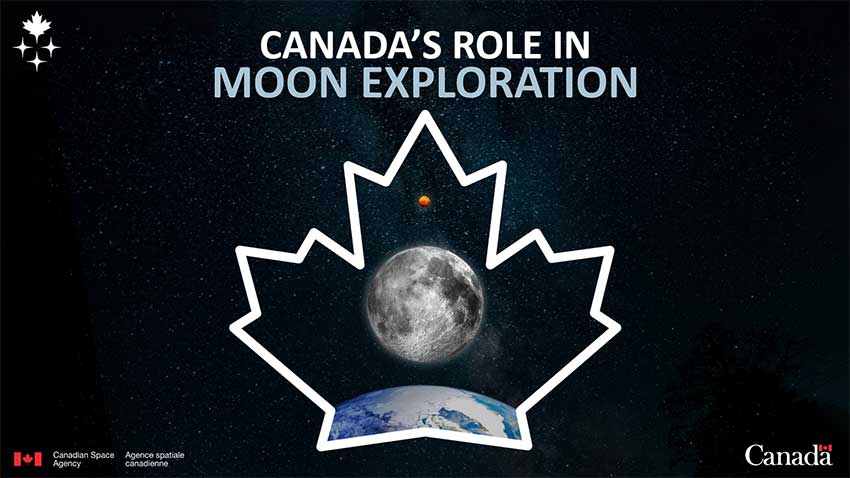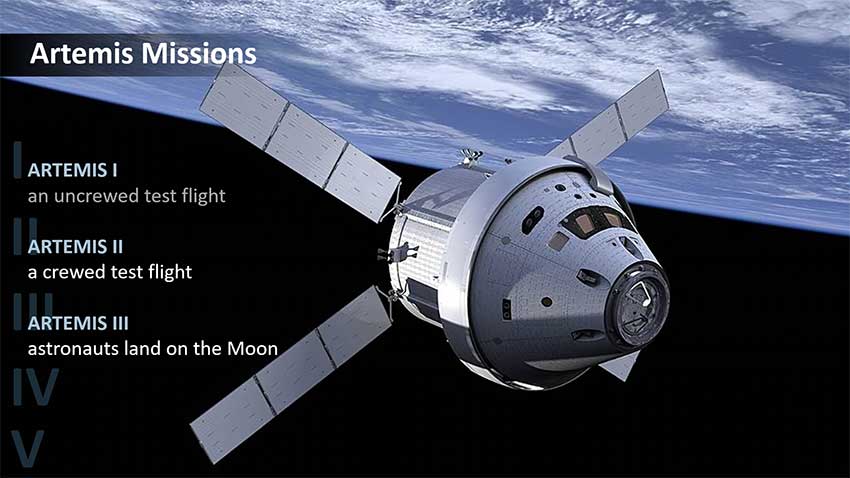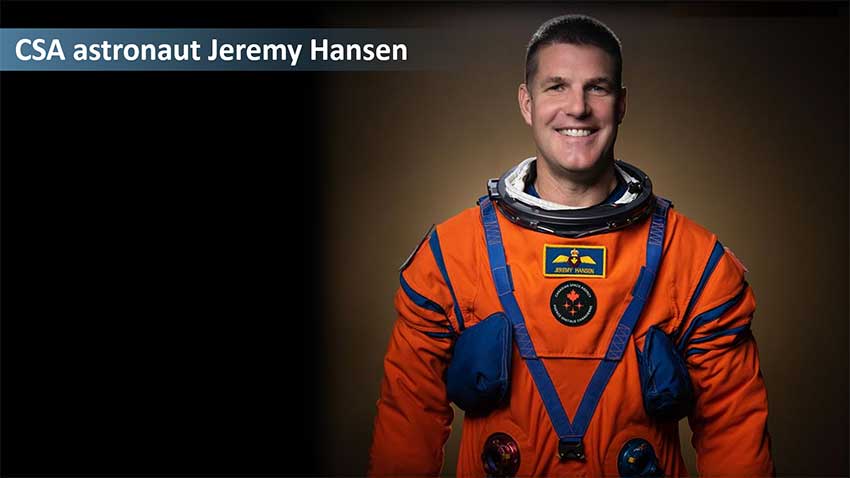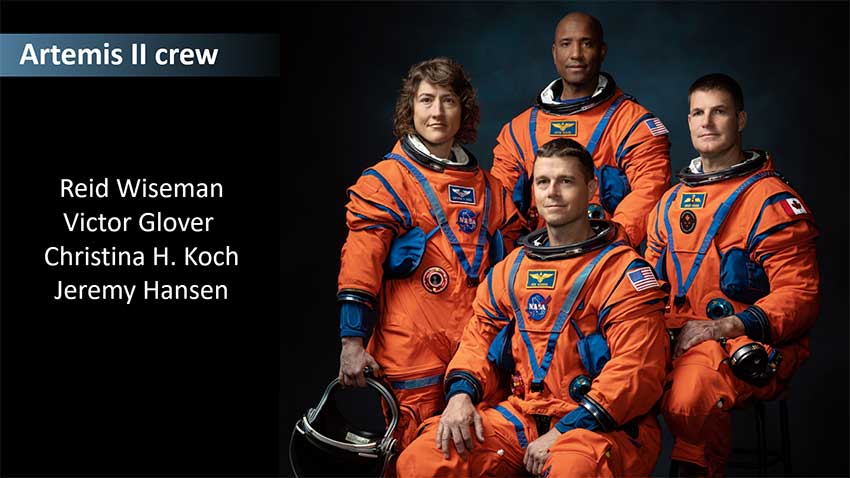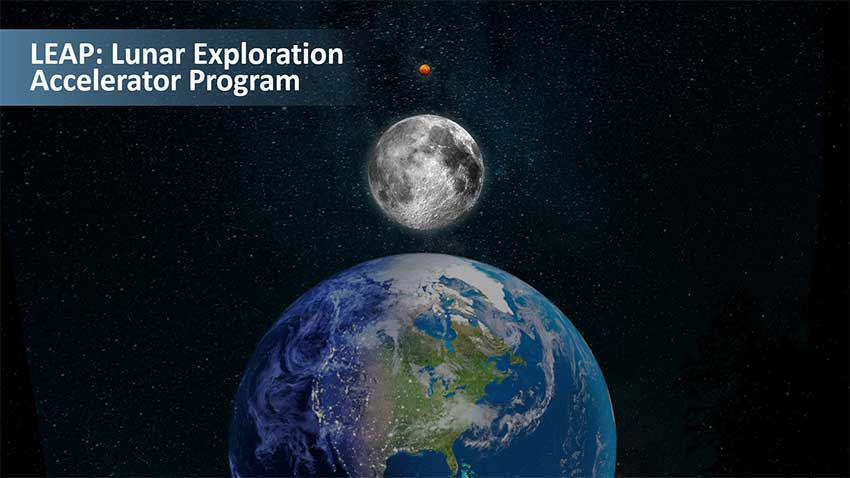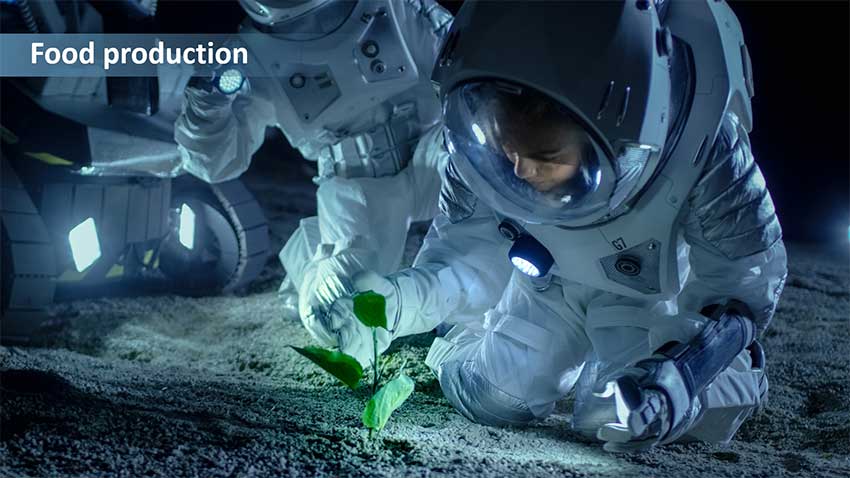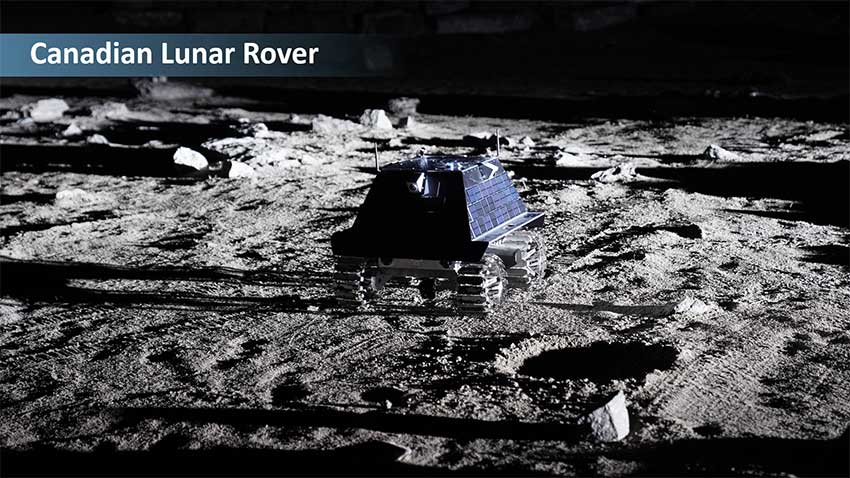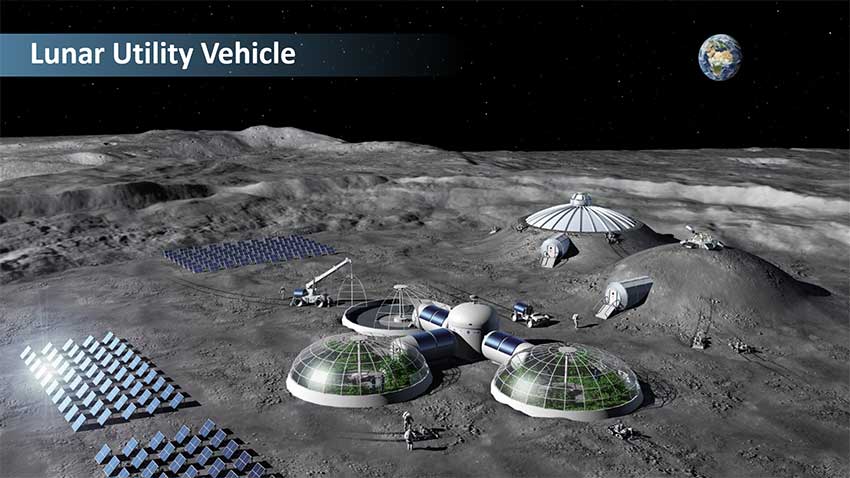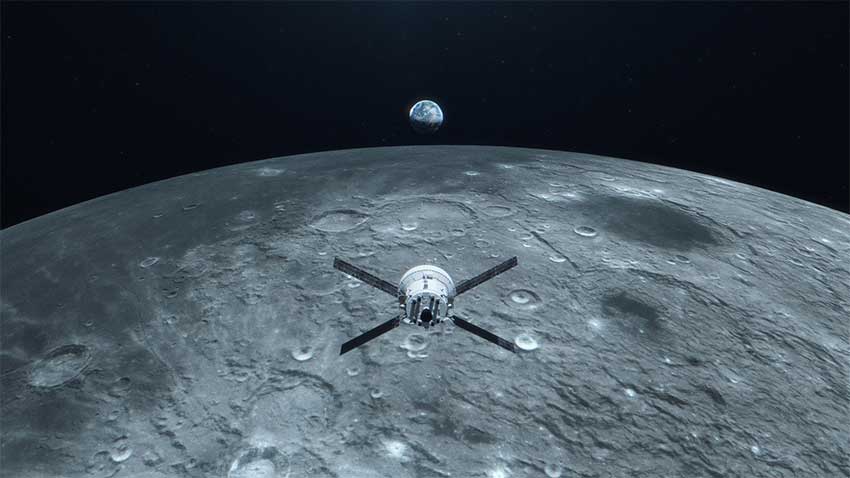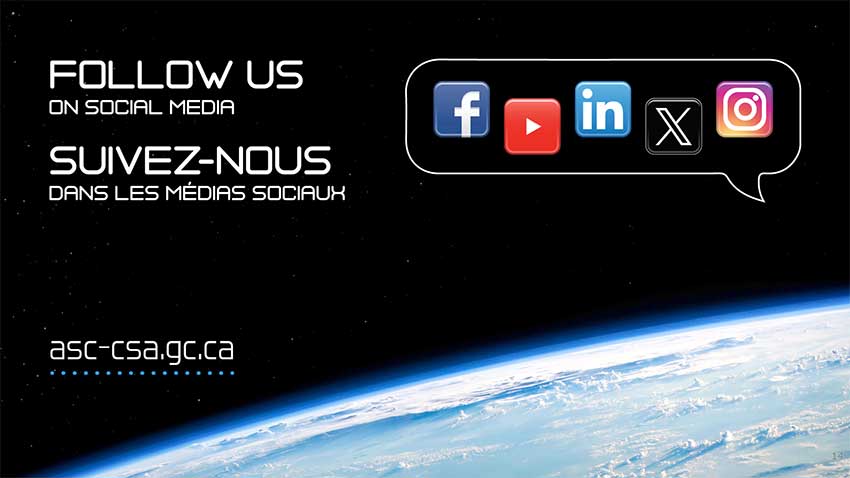Speakers' kit - Canada's role in Moon exploration
Resources that space ambassadors and experts can use to deliver presentations about Canada's role in Moon exploration to audiences across Canada.
Presentation
Multimedia
Frequently asked questions
Artemis program
-
What is the Artemis program?
The NASA-led Artemis program is a multi-pronged collaboration between international space agencies and commercial partners to return humanity to the Moon. The program includes contributions from partner agencies such as the Canadian Space Agency (CSA), the European Space Agency, and the Japan Aerospace Exploration Agency, and participation from several companies.
The program includes complex missions that will lay the foundation for long-term human and robotic exploration of the Moon, as well as the construction of the Lunar Gateway, a small space station in lunar orbit. As part of the current plans, the Human Landing System would be used to travel from orbit to the surface of the Moon at the Artemis Base Camp.
This renewed chapter of Moon exploration opens a range of opportunities across scientific disciplines, technology development, and engineering – and lays the groundwork for human exploration beyond the Moon, onward to Mars. Through the Artemis missions, NASA will land the first woman and the first person of colour on the lunar surface.
Current mission plans include:
- Artemis I, an uncrewed test flight of the Orion spacecraft, set to launch on the Space Launch System (SLS) rocket in ;
- Artemis II, the first-ever crewed test flight of the Orion spacecraft, targeted to launch on the SLS rocket no later than ; and
- Artemis III, the mission that will fly astronauts to the Moon, currently targeted for no earlier than . The mission may land humans on the lunar surface.
-
Will a Canadian fly to the Moon?
In return for contributing Canadarm3 to the Lunar Gateway, Canada receives two astronaut flights to the Moon. A CSA astronaut will be part of Artemis II, the first crewed mission to the Moon since . This mission would make Canada the second country to have an astronaut fly around the Moon. A CSA astronaut is also planned to fly to the Lunar Gateway.
-
How will astronauts get to the Moon?
NASA's Orion is a new exploration spacecraft that will carry Artemis crews to the Moon. Orion will be launched by NASA's Space Launch System (SLS) rocket from Kennedy Space Center in Florida.
Once the Lunar Gateway becomes operational, Orion will dock to the small station in orbit around the Moon. Astronauts would then use the Human Landing System to get from lunar orbit to the surface of the Moon at the Artemis Base Camp.
-
What is the Lunar Gateway?
The Lunar Gateway is a small space station destined for lunar orbit. About one-sixth of the size of the International Space Station, and a thousand times farther from Earth, this new outpost will be developed, serviced, and utilized in collaboration with international and commercial partners.
Canada is contributing Canadarm3, a smart robotic system, to the Lunar Gateway. Canadarm3 will maintain, repair, and inspect the Gateway, capture visiting vehicles, relocate Gateway modules, help astronauts during spacewalks, and enable science both in lunar orbit and on the surface of the Moon.
The Orion spacecraft will dock with the Lunar Gateway. Astronauts can live onboard for up to three months. Crew will venture to the lunar surface from the station. The Lunar Gateway is critical to support human presence on and around the Moon.
Lunar exploration will serve as a testbed for future missions to Mars.
-
When will the next crewed mission go to the Moon?
Artemis II, the first-ever crewed test flight of the Orion spacecraft, is targeted to launch on the SLS rocket no later than . Like the Apollo program over 50 years ago, Artemis will begin with missions around the Moon before a mission that lands on the lunar surface.
-
How long will the Artemis I mission last?
The total mission duration of Artemis I is between 26 and 42 days, depending on the final trajectory. The mission has three main phases:
- launch and outbound journey to the Moon, lasting 8 to 14 days;
- time in lunar orbit, which could last 6 to 19 days; and
- the return cruise back to Earth, in 9 to 19 days.
-
Why are we going to the Moon?
Learning how to tackle the challenges of living on another world is vital to improving many facets of our own lives here on Earth. Studying the Moon can increase our knowledge about the origin and history of Earth, the Moon, and our solar system. Developing ways to care for crews venturing farther from Earth can help advance health care solutions, novel food production technologies, and other innovations that can help enhance life on Earth.
Canada's role in the Lunar Gateway and Moon exploration provides significant scientific and economic opportunities within a growing space sector. Our participation paves the way for Canadian researchers and commercial organizations to conduct science and technology activities in lunar orbit and on the Moon's surface.
Returning to the Moon also encourages young Canadians to reach for the stars, becoming the next generation of scientists, engineers, and explorers.
-
Where does the name Artemis come from?
The program is named after the twin sister of mythical Apollo, the namesake of the lunar campaign that ended in . The Artemis program shares its name with the Greek mythological figure known as the goddess of the Moon and the hunt. As the "
torch bringer,
" Artemis will light the way for human exploration of the red planet.
Space Launch System (SLS)
-
What is the Space Launch System (SLS)?
NASA's SLS is the rocket designed for human space travel. The SLS will launch the Orion spacecraft to the Moon. It is more powerful than the Saturn V rocket that brought astronauts to the Moon during the Apollo missions. Using additional rocket boosters and stages, the system can evolve and expand according to crew and cargo mission requirements.
-
What fuel does the SLS use?
The SLS has a core stage and two solid rocket boosters. Its core stage holds over 2.7 million litres of liquid hydrogen and liquid oxygen.
-
Where will the SLS launch?
The SLS will launch from NASA's updated Launch Complex 39B at Kennedy Space Center in Cape Canaveral, Florida.
-
When will the first crew launch with the SLS?
Artemis II, the first-ever crewed test flight of the Orion spacecraft, is targeted to launch on the SLS rocket no later than . A CSA astronaut will be part of Artemis II, the first crewed mission to the Moon since .
Orion
-
What is Orion?
NASA's Orion spacecraft is a new exploration vehicle that will carry Artemis crews to space. Orion is designed to launch on NASA's SLS rocket. The spacecraft features life support systems and emergency abort capabilities. It includes:
- a Crew Module, where the crew will live and work during Artemis missions; and
- the European Space Agency's European Service Module, responsible for providing electricity, water, oxygen and nitrogen as well as keeping the spacecraft at the right temperature and on course.
Orion will carry crews back to the Moon for the first time since , and farther into space than ever before.
-
How many people can fit in the Orion capsule?
The Crew Module can support a crew of four.
-
How fast can Orion travel?
During re-entry into Earth's atmosphere, Orion will be travelling around 39,600 km per hour, producing temperatures of up to 2,750 degrees Celsius. Orion's parachutes are designed to slow the capsule for landing from speeds exceeding 40,000 km per hour.
-
How far will Orion travel?
During Artemis I, Orion will travel more than 64,000 km past the Moon, farther into space than any other spacecraft designed for humans.
-
How is Orion powered?
At launch, the SLS rocket provides thrust. After separating from the rocket, Orion's four solar arrays will be deployed and batteries will provide electrical power. Engines and thrusters on Orion's European Service Module, using liquid oxygen and hydrogen for fuel, will power course adjustments and insertion into lunar orbit. For the return trip, Orion will use the engines on the European Service Module and be assisted by the pull of Earth's gravity.
